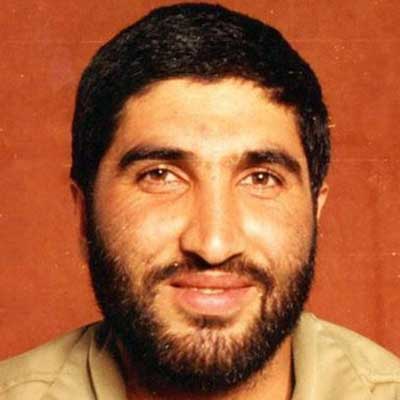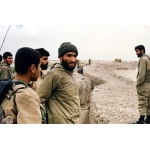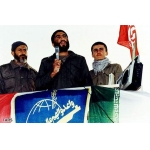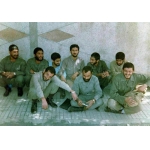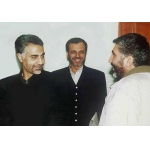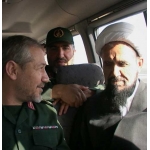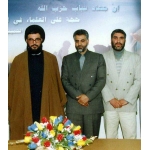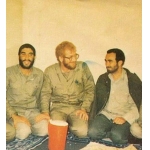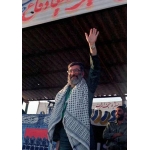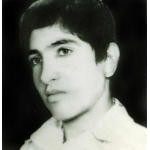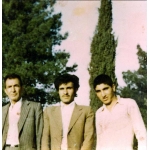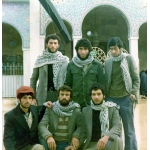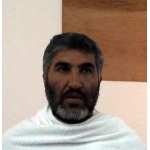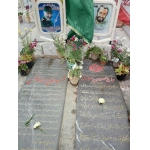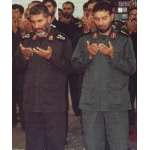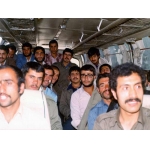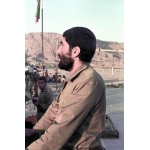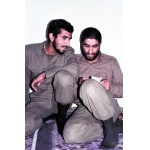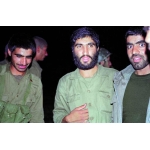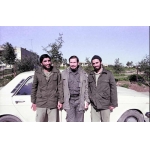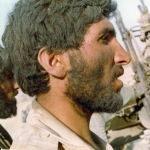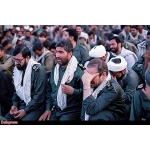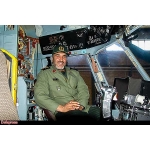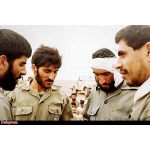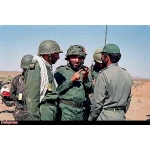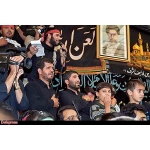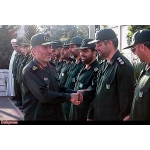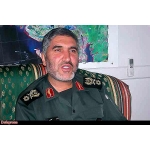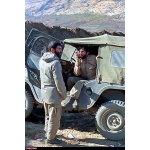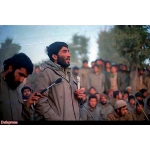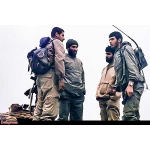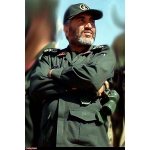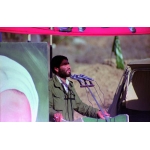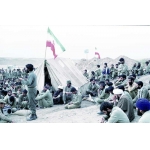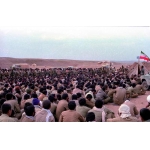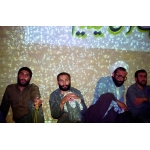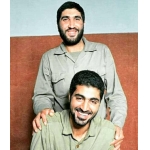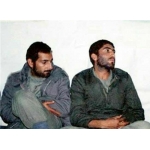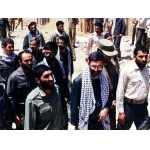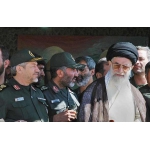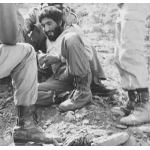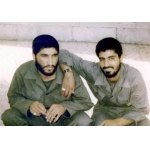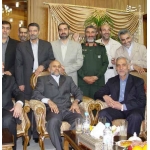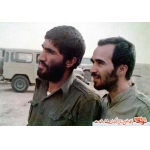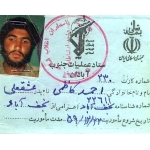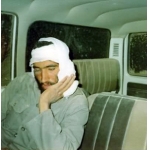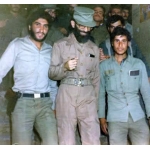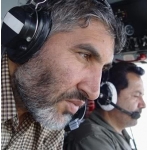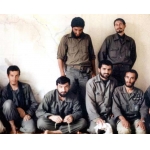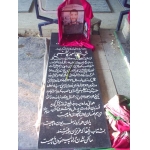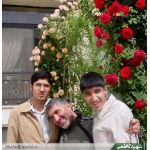Kazemi, Ahmad
By: Fatemeh Norouzi
987 بازدید
Kazemi, Ahmad
By: Fatemeh Norouzi
Ahmad Kazemi (1959–2006), was the commander of the 8th Najaf Ashraf Division of the Islamic Revolutionary Guard Corps (IRGC) during the Iran-Iraq War. He also served as the commander of Hamzeh Seyyed al-Shohada Headquarters and later as the commander of both the IRGC Air Force and Ground Force. He was martyred in a plane crash in 2006.
Ahmad Kazemi was born on April 22, 1959, in Najafabad, Isfahan. He began his revolutionary activities in his youth. On December 21, 1977, which coincided with the Day of Ashura, he was arrested during a mourning ceremony and spent fifteen days imprisoned in Dastgerd Rrison. In 1979, he graduated from Dr. Shariati Technical School in Najafabad with a diploma in agricultural machinery.
In December 1979, he traveled to Syria with a group of Iranian volunteers led by Mohammad Montazeri to fight the occupiers of Palestine. He underwent 45 days of guerrilla warfare training at the Hamouriyah military camp under the supervision of the Fatah organization
In early 1980, coinciding with the anti-revolutionary movements in Kurdistan, after completing a fifteen-day military training course in Najafabad, he was dispatched to Kermanshah. From Kermanshah he went to Sanandaj. In April 1980, he participated in clearing the Sanandaj-Saqqez Road. After two months, he returned to Najafabad, and on May 22, 1980, he joined the Islamic Revolutionary Guard Corps (IRGC).[1]
During the early days of Iraq's invasion of Iran, in October 1980, he was dispatched to Sanandaj with a 35-member group from the Najafabad branch of the IRGC. During the clearing of one of the Divandarreh Routes, he was injured in the leg and hospitalized at the Shaheed Mostafa Khomeini Hospital in Tehran. After hearing about the fall of Khorramshahr in November, he went to the south and, along with a group led by Gholamreza Mohammadi, headed to the Golf Barracks in Ahvaz.[2]
In late 1980, he went to the Fayyaziyeh front and was appointed as deputy commander and later the commander there. By the end of August 1981, he had expanded the organization of forces stationed in Fayyaziyeh to three combat battalions.[3]
On September 27, 1981, with his battalions and the 2nd Brigade of the 77th Khorasan Division, he participated in Operation Samen-ol-A'emeh to break the siege of Abadan.[4] On November 24, 1981, he was assigned by Gholam-Ali Rashid to form the 8th Najaf Ashraf Brigade. During Operation Tariq al-Qods, although he had no assigned mission, he brought a battalion of forces to assist Hossein Kharrazi, commander of the 14th Imam Hossein Brigade, and Morteza Ghorbani, commander of the 25th Karbala Brigade.[5]
With the complete organization of the 8th Najaf Ashraf Brigade, he participated in Operation Fath-ol-Mobin on March 22, 1982. In the spring of 1982, during Operation Beit-ol-Moqaddas, he alongside Hossein Kharrazi, played a key role in the liberation of Khorramshahr. He was injured in the face during this operation but did not leave the battlefield.[6]
Ahmad Kazemi also commanded the 8th Najaf Ashraf Brigade during Operations Ramadan (July 13, 1982) and Moharram (October 31, 1982). Although Operation Ramadan was unsuccessful, under Kazemi’s command, the 8th Najaf Ashraf Brigade advanced forty kilometers into enemy territory, reaching the Khatiban Canal, but had to retreat due to the lack of reinforcement.[7] After Operation Moharram, in November 1982, the 8th Najaf Ashraf Brigade was upgraded to a division.
Ahmad Kazemi, along with his division, participated in the following operations: Prelude to Valfajr on February 6, 1983; Valfajr 1 on April 10, 1983, in the northwest of Fakkah; Valfajr 2 on July 20, 1983, in the Haj Omran region; and Valfajr 4 on October 19, 1983, in the Panjwin region of Iraq.[8]
On February 21, 1984, during Operation Kheibar, when the Majnoon Islands were liberated, his right middle finger was severed due to shrapnel injury. After Operation Kheibar he remained the division commander until the end of the war, and took part in most major operations, including Badr (March 11, 1985) in east of the Tigris, Valfajr 8 (February 9, 1986) in Faw, Karbala 4 (December 24, 1986) on the Um al-Rasas and Um al-Babi Islands, Karbala 5 (January 9, 1987) in the Shalamcheh-Basra axis, Valfajr 10 (March 16, 1988) in Halabja, Beit-ol-Moqaddas 7 (June 13, 1988) in Shalamcheh, and others.
Ahmad Kazemi's marriage to his wife took place on December 14, 1985, officiated by Imam Khomeini. The couple had two children, named Mohammad Mahdi and Mohammad Saeed.[9]
After the war, Ahmad Kazemi continued as the commander of the 8th Najaf Ashraf Division and, in 1990 and 1991, while retaining his position, also served as Deputy for Operations of the IRGC Ground Forces. By the order of the Commander-in-Chief of the IRGC on June 14, 1993, he was appointed as the commander of Hamzeh Seyyed al-Shohada Headquarters. During this time, he took numerous measures to clear the northwestern region of Iran from anti-revolutionary forces. Additionally, he signed a political-military agreement with the leaders of the Kurdish forces in the Sanjaq encampment, encouraging them to lay down their arms and engage in political activities.
Ahmad Kazemi's farewell ceremony from the 8th Najaf Ashraf Division, after sixteen years of command, was held in September 1997. On December 18, 1997, while still holding the command of Hamzeh Seyyed al-Shohada Headquarters in the northwest of the country, he was appointed as the commander of the 14th Imam Hossein Division.[10]
On June 29, 2000, Ahmad Kazemi was appointed as the commander of the IRGC Air Force, and during his tenure, this force was equipped with Sukhoi-24 fighter jets for the first time.
During the Bam earthquake in January 2004, he was among the first to arrive in the city, utilizing the IRGC Air Force’s resources to assist those who were affected.[11]
After the war, despite having many responsibilities, Ahmad Kazemi continued his education. He earned a Master's degree in Human Geography from the University of Tehran and a degree in Defense Management from the Command and Staff College. In 2005, he was accepted into a Ph.D. program in Strategic Sciences but, due to his heavy workload, was unable to continue his studies. On August 20, 2005, he was appointed as the commander of the IRGC Ground Forces.[12]
After the war, Ahmad Kazemi received three "Fath" (Victory) medals from the Leader of the Islamic Revolution, Ayatollah Seyyed Ali Khamenei.[13]
On January 9, 2006, at 9:32 AM, Ahmad Kazemi was martyred in a plane crash involving a Falcon jet near Urmia, along with several other commanders of the IRGC Ground Forces.[14] In accordance with his will, his body was buried in the Golestan Shohada cemetery in Isfahan, and a memorial stone was placed for him in section 29 of Behesht Zahra cemetery in Tehran.
.
[1], Morteza, The First Traveler of Khorramshahr, Tehran, Foundation for the Preservation of Works and Publication of Masah Sacred Defense Values, 2008, pp. 13-16.
[2] Ibid., pp. 16 and 17; Azizi Nik, Nadereh, Payane Gebteh, Tehran: Islamic Revolution Documents Center Publications, 2011, pp. 15 and 16.
[3] Masah, Morteza, The First Traveler of Khorramshahr, p. 17.
[4] Ibid., p. 18 and 19.
[5] Ibid., p. 19; Sarmadi, Saeed, Commanders of the Sacred Defense: Martyr Ahmad Kazemi, Tehran: Sacred Defense Documentation and Research Center, 2011, p. 63.
[6] Shahed Yaran, No. 74, January 2011, pp. 6 and 7.
[7] Ibid., p. 7; Atlas of the Iran-Iraq War, Tehran: Sacred Defense Documentation and Research Center of the Islamic Revolutionary Guard Corps, Vol. 2, 2010, p. 68.
[8] Masah, Morteza, The First Traveler to Khorramshahr, pp. 19-21; Atlas of the Iran-Iraq War, p. 90.
[9] Masah, Morteza, The First Traveler of Khorramshahr, pp. 21-22; Shahed Yaran, Vol. 74, p. 8; Atlas of the Iran-Iraq War, p. 108.
[10] Masah, Morteza, The First Traveler to Khorramshahr, pp. 22-24.
[11] Ibid., p. 24; Shahed Yaran, vol. 74, p. 9.
[12] Masah, Morteza, The First Traveler of Khorramshahr, pp. 24 and 25.
[13] Witness of the Friends, Vol. 74, p. 9.
[14] Masah, Morteza, The First Traveler of Khorramshahr, p. 25.


